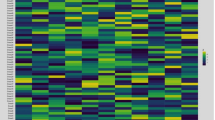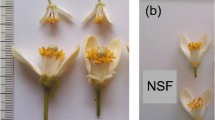Summary
Three Cucumis sativus L. (CS) lines adapted to USA growing conditions were used as female parents in crosses to one line each of seven Cucumis sativus var. hardwickii (R.) Alef. (CH) accessions used as male parents to determine the relative combining ability of the CH accessions for six horticultural characters. The 21 F1 progenies were grown in a randomized complete block design in two locations and evaluated for fruit number, lateral branch number, fruit length, fruit length/diameter ratio, number of female flowering nodes, and days to anthesis. General combining ability (GCA) was significant for all characters in each location. Specific combining ability (SCA) was significant for all characters except days to anthesis in one location and lateral branch number in both locations. Significant location × combining ability interactions were also evident for several characters. Results suggest that CH may be useful for improving fruit yield in commercial cucumber, but that limitations may lie in the attainment of acceptable fruit.
Similar content being viewed by others
References
Baker R.J., 1978. Issues in diallel analysis. Crop Sci 18: 533–536.
Bliss F.A., 1981. Utilization of vegetable germplasm. Hort-Science 16: 129–132.
Comstock R.E. & H.F.Robinson, 1948. The components of genetic variance in populations of biparental progenies and their use in estimating the average degree of dominance. Biometrics 4: 254–266.
Comstock R.E. & H.F.Robinson, 1952. Estimation of average dominance of genes. In: Heterosis, pp. 494–517. Iowa State College Press, Ames.
Della Vecchia, P.T., 1982. Inheritance of short day response to flowering and of some fruit characteristics in crosses between Cucumis sativus var. hardwickii (R.) Alef. and Cucumis sativus L. lines. Ph.D. Thesis. Univ. of Wisconsin, Madison, USA.
Della Vecchia P.T. & C.E.Peterson, 1984. Inheritance of flowering response in cucumber. J Amer Soc Hort Sci 109: 761–763.
Denna D.W., 1973. Effects of genetic parthenocarpy and gynoecious flowering habit on fruit production and growth in cucumber, Cucumis sativus L. J Amer Soc Hort Sci 98: 602–604.
Eberhart S.A., M.N.Harrison & F.Ogata, 1967. A comprehensive breeding system. Der Zuchter 37: 169–174.
El-Shawaf I.I.S. & L.R.Baker, 1981a. Combining ability and genetic variances of GXHF1 hybrids for parthenocarpic yield in gynoecious pickling cucumber for once over mechanical harvest. J Amer Soc Hort Sci 106: 365–370.
El-Shawaf I.I.S. & L.R.Baker, 1981b. Inheritance of parthenocarpic yield in gynoecious pickling cucumber for once over mechanical harvest by diallel analysis of six gynoecious lines. J Amer Soc Hort Sci 106: 359–365.
El-Shawaf I.I.S. & L.R.Baker, 1981c. Performance of hermaphroditic pollen parents in crosses with gynoecious lines for parthenocarpic yield in gynoecious pickling cucumber for once-over mechanical harvest. J Amer Soc Hort Sci 106: 356–359.
Fuller G.L. & C.A.Leopold, 1977. The role of nucleic acid synthesis in cucumber fruit set. J Amer Soc Hort Sci 102: 384–388.
Ghaderi A. & R.L.Lower, 1979a. Analysis of generation means for yield in six crosses of cucumber. J Amer Soc Hort Sci 104: 567–572.
Ghaderi A. & R.L.Lower, 1979b. Heterosis and inbreeding depression for yield in populations derived from six crosses of cucumber. J Amer Soc Hort Sci 104: 564–567.
Ghaderi A. & R.L.Lower, 1981. Estimates of genetic variance for yield in pickling cucumbers. J Amer Soc Hort Sci 106: 237–239.
Hallauer A.R. & J.B.Miranda, 1981. Quantitative genetics in maize breeding, pp. 64–116. Iowa State Univ. Press, Ames.
Horst, E.K., 1977. Vegetative and reproductive behavior of Cucumis hardwickii and Cucumis sativus as influenced by photoperiod, temperature, and planting density. M.S. Thesis. North Carolina State Univ., Raleigh, USA.
Horst E.K. & R.L.Lower, 1978. Cucumis hardwickii: A source of germplasm for the cucumber breeder. Cucurbit Genetics Coop Rpt 1: 5.
Hutchins A.E., 1938. Some examples of heterosis in the cucumber, Cucumis sativus. Proc Amer Soc Hort Sci 36: 660–664.
Hutchins A.E., 1940. Inheritance in the cucumber. J Agr Res 60: 117–128.
Lower R.L., J.Nienhuis & C.H.Miller, 1982. Gene action and heterosis for yield and vegetative characteristics in a cross between a gynoecious pickling cucumber inbred and a Cucumis sativus var. hardwickii line. J Amer Soc Hort Sci 107: 75–78.
McCollum, J.P., 1934. Vegetative and reproductive responses associated with fruit development in cucumber. Cornell Univ Agric Expt Sta Memo 163.
Miller J.C. & J.E.Quisenberry, 1976. Inheritance of time to flowering and its relationship to crop maturity in cucumber. J Amer Soc Hort Sci 101: 497–500.
National Academy of Sciences, 1972. Genetic vulnerability of major crops. Washington, D.C.
Nienhuis, J., 1982. Response to different selection procedures for increased fruit yield in two pickling cucumber populations. Ph.D. Thesis. Univ. of Wisconsin, Madison, USA.
Nienhuis J. & R.L.Lower, 1980. Influence of reciprocal donor scions on fruit setting characteristics of recipient scions of Cucumis sativus and C. hardwickii R. Cucurbit Genetics Coop Rpt 3: 17–19.
Owens K.W., F.A.Bliss & C.E.Peterson, 1985. Genetic variation within and between two cucumber populations derived via the inbred backcross line method. J Amer Soc Hort Sci 110: 437–441.
Peterson C.E., 1969. A gynoecious inbred line of cucumbers. Mich Agr Exp Sta Quart Bul 43: 40–42.
Peterson C.E., 1975. Plant introductions in the improvement of vegetable cultivars. HortScience 10: 575–579.
Royle J.F., 1839. Illustrations of the botany and other branches of the natural history of the himalayan mountains and of the flora of cashmere. [Reprint ed., 1970. Today and Tomorrows Publishers, New Delhi 5, India.].
Schuman D.A., J.E.Staub & B.E.Struckmeyer, 1985. Morphological comparisons between two botanical varieties Cucumis sativus and hardwickii. Cucurbit Genetics Coop Rpt 8: 15–17.
Shifriss O., 1961. Sex control in cucumber. J Heredity 52: 5–12.
Shifriss O., & W.L.George, 1965. Delayed germination and flowering in cucumber. Nature 206: 424–425.
Simmonds N.W., 1979. Principles of Crop Improvement. Longman Group Ltd., London.
Smith O.S., R.L.Lower & R.H.Moll, 1978. Estimates of heritabilities and variance components in pickling cucumber. J Amer Soc Hort Sci 103: 222–225.
Snedecor G.W. & W.G.Cochran, 1980. Statistical Methods. Iowa State Univ Press, Ames, Iowa, USA.
Sprague G.F. & L.A.Tatum, 1942. General vs. specific combining ability in single crosses of corn. J Amer Soc Agron 34: 932–942.
Staub J.E. & R.S.Kupper, 1985. Use of Cucumis sativus var. hardwickii germplasm in backcrosses with Cucumis sativus var. sativus. HortScience 20: 436–438.
Tasdighi M. & L.R.Baker, 1981a. Combining ability for femaleness and yield in single and 3-way crosses of pickling cucumber intended for once-over harvest. Euphytica 30: 183–192.
Tasdighi M. & L.R.Baker, 1981b. Comparison of single and three-way crosses of pickling cucumber hybrids for femaleness and yield by once-over harvest. J Amer Soc Hort Sci 106: 370–373.
Tiedjens V.A., 1928. Sex ratios in cucumber flowers as effected by different conditions of soil and light. J Agr Res 36: 721–746.
Author information
Authors and Affiliations
Additional information
Research supported by the College of Agric. and Life Sci., Univ. of Wisconsin, Madison; USDA, ARS, and by funds from Pickle Packers Intl., Inc. Mention of a trademark, proprietary product, or vendor does not constitute a guarantee of warranty of the product by the USDA and does not imply its improval to the exclusion of the other products or vendors that may also be suitable.
Rights and permissions
About this article
Cite this article
Kupper, R.S., Staub, J.E. Combining ability between lines of Cucumis sativus L. and Cucumis sativus var. hardwickii (R.) Alef. Euphytica 38, 197–210 (1988). https://doi.org/10.1007/BF00023522
Received:
Accepted:
Issue Date:
DOI: https://doi.org/10.1007/BF00023522




